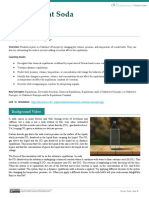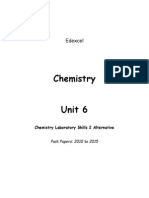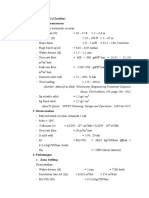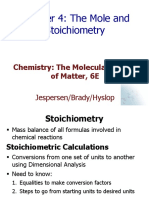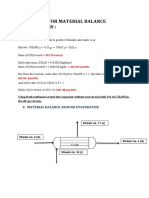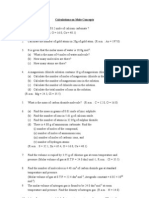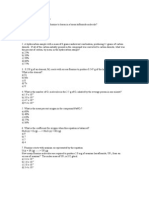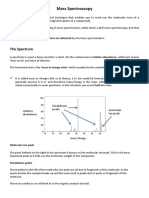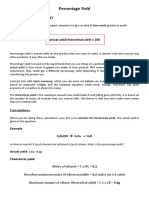PV NRT Edexcel
PV NRT Edexcel
Uploaded by
Kevin The Chemistry TutorCopyright:
PV NRT Edexcel
PV NRT Edexcel
Uploaded by
Kevin The Chemistry TutorOriginal Description:
Original Title
Copyright
Share this document
Did you find this document useful?
Is this content inappropriate?
Copyright:
PV NRT Edexcel
PV NRT Edexcel
Uploaded by
Kevin The Chemistry TutorCopyright:
PV = nRT
This should be easy as you have an equation and more or less just have to put the numbers in.
P = pressure: must be in Pascals (Pa). They quite often give the value in kPa, therefore you need to
multiply by 1000 Pa.
If you see the units as Nm-2, these are the same as Pa.
V = volume: must be in m3. Be careful with this as you are very used to cm3 or dm3.
cm3 m3 divide by 1 million
dm3 m3 divide by 1000
n = the number of moles
R = the gas constant: 8.31 J K-1 mol-1 (should be given in the question)
T= temperature: in Kelvin (K). If they give the temperature in degrees celsius, you have to add 273 to
convert to K
You may see the following phrases used in questions:
STP: standard temperature and pressure. Temp is 0 C or 273 K. Pressure is 100,000 Pa.
RTP: room temperature and pressure. Temp is 25 C or 293 K. Pressure is 100,000 Pa.
And thats about it really. Its just a case of practise as they could ask you to work the volume or the
number of moles or the temperature so you will need to be able to rearrange. And be very careful with
the units of P and V.
You also need to be careful with what exactly you are working out and what you have worked out.
Sometimes there will be more than one gas in the products and you need to know if you have the moles
of both the gases added together. The 1st and 3rd questions below are examples of this.
Example 1
4NH3(g) + 5O2(g) 4NO(g) + 6H2O(g)
Calculate the number of moles of NO produced. The gases occupied a volume of 4.31 m3 at 25 C and
100kPa.
Using equation PV = nRT. You can either put the numbers in first, multiply them then rearrange or
rearrange straight away, its up to you. I put in the numbers first in this case:
P = 100,000 (multiply kPa x 1000),
V = 4.31
n is what we want to work out
R is always 8.31
T = 298 (25 + 273)
100,000 x 4.31 = n x 8.31 x 298
431,000 = 2476.38 x n
n = 431000/2476.38
= 174.04 moles (total moles of gas)
You also have to be careful here. We have worked out the total number of moles of gas produced, NOT
the moles of NO.
From the equation above, we have 10 moles of gas in total produced (4NO and 6H 2O). We are only
interested in NO, which makes up 4/10 of the total. Therefore we need to divide by 2.5:
174.04/2.5 = 69.2 moles of NO
Example 2
In an experiment, 0.658 moles of CO2 were produced, which occupied 0.0220 m3 at a pressure of 100 kPa.
Calculate the temperature of the CO2.
This should be quite easy. We have all the numbers that we need, except we need to convert kPa to Pa
by x1000. Using:
PV = nRT
We can rearrange this equation to give:
T = PV/nR
T = 100000 x 0.022/0.658 x 8.31
T = 402 K
Example 3
B2O3(s) + 3C(s) + 3Cl2(g) 2BCl3(g) + 3CO(g)
The two gases produced occupied a volume of 5000 cm3 at a pressure of 100 kPa and a temperature of
298 K. Calculate the mass of boron oxide that reacted.
The emphasis in this question is on the two gases that are produced, so we need to work out the number
of moles of these gases. Also, the volume is given in cm3 so we need to divide by 1000 to get m3:
PV = nRT
n = PV/RT
n = 100000 x 5x10-3/8.31 x 298
n = 0.202 moles of gas produced
We have the total gas produced i.e. BCl3 and CO. Now we want to work out the grams of B2O3:
We have 5 moles of gas in total which = 0.202 moles. So it is a 1:5 ratio of B2O3:(BCl3 + CO)
Therefore we need to divide the moles by 5: 0.202/5 = 0.0404 moles B2O3
So to get the grams we just use number of moles = mass/RFM:
Mass = number of moles x RFM
Mass = 0.0404 x 69.6
=2.81 g
Example 4
4Fe(NO3)3(s) 2Fe2O3(s) + 12NO2(g) + 3O2(g)
Calculate the volume, in m3, of 0.0268 moles of nitrogen dioxide gas at 293 C and 100 kPa.
Remember to add 273 to get the temperature in Kelvin!
PV = nRT
V = nRT/P
V = 0.0268 x 8.31 x 566/100000
V = 0.00126 m3
When calculating volume it is usually a small number as the answer is in m3. They may ask for it in
cm3 or dm3, so you will need to convert as shown on page 1 of this tutorial.
You might also like
- Solutions For Environmental Chemistry A Global Perspective 4th Us Edition by VanloonDocument15 pagesSolutions For Environmental Chemistry A Global Perspective 4th Us Edition by Vanloontest.banky0% (1)
- 16 - Flat vs. Fizzy Soda CompleteDocument9 pages16 - Flat vs. Fizzy Soda CompleteAli AlzarooniNo ratings yet
- 17 Quantitative Aspects of Chemical ChangeDocument30 pages17 Quantitative Aspects of Chemical Changeapi-235269401No ratings yet
- Ideal Gas Law ProblemsDocument4 pagesIdeal Gas Law ProblemsJopie Aranda0% (1)
- FTIRDocument25 pagesFTIRAnubhav ShuklaNo ratings yet
- Relative Atomic/molecular Mass & Mole ConceptDocument18 pagesRelative Atomic/molecular Mass & Mole Conceptcikgu aisyahNo ratings yet
- General Chemistry I Handout 6Document5 pagesGeneral Chemistry I Handout 6Roxan Oxima ClabriaNo ratings yet
- Enthalpies of FormationDocument14 pagesEnthalpies of FormationAndrea Badua100% (1)
- 1.1 Atoms and MoleculesDocument43 pages1.1 Atoms and MoleculesDinie BidiNo ratings yet
- Air Pollution Prevention and Control: Dr. Wesam Al MadhounDocument52 pagesAir Pollution Prevention and Control: Dr. Wesam Al MadhounAIZAZ SHAIKHNo ratings yet
- Edexcel A2 Chemistry Paper 6Document148 pagesEdexcel A2 Chemistry Paper 6AbdulRahman MustafaNo ratings yet
- From Copper To Copper LabDocument8 pagesFrom Copper To Copper LabShakilMirza100% (9)
- Air PollutionDocument3 pagesAir PollutionMin KrNo ratings yet
- Definitions - Chemistry IAL EdexcelDocument7 pagesDefinitions - Chemistry IAL EdexcelPanagiotis ScordisNo ratings yet
- Chapter 12 StoichiometryDocument51 pagesChapter 12 StoichiometryGail DomingoNo ratings yet
- Reversible ReactionsDocument39 pagesReversible ReactionsUsmaanNo ratings yet
- Chemical Bonding - FINALDocument9 pagesChemical Bonding - FINALSabsNo ratings yet
- 3.1 Notes - Avogadro & The MoleDocument5 pages3.1 Notes - Avogadro & The MoleRoddyNo ratings yet
- Lab FTIR PDFDocument2 pagesLab FTIR PDFNuraienee JaminganNo ratings yet
- 4, Material Balance ReactionDocument87 pages4, Material Balance ReactionDanang Präbowo100% (2)
- Bak Pengendap II (Clarifier) 1. Kriteria PerencanaanDocument13 pagesBak Pengendap II (Clarifier) 1. Kriteria PerencanaanHSE DAPNo ratings yet
- Chemistry Notes PT 1Document55 pagesChemistry Notes PT 1EdcademiaNo ratings yet
- Tutor Next Door O Level Chemistry (6092) Summary Notes 1 Experimental ChemistryDocument4 pagesTutor Next Door O Level Chemistry (6092) Summary Notes 1 Experimental ChemistryArvin LiangdyNo ratings yet
- StoikhiometriDocument89 pagesStoikhiometrikembar ayu100% (2)
- Material Balance CalculationsDocument10 pagesMaterial Balance CalculationsAnjali BalmikiNo ratings yet
- Chapter18 Answer KeyDocument6 pagesChapter18 Answer KeyRavindra KempaiahNo ratings yet
- h2 Chem ChecklistDocument3 pagesh2 Chem ChecklistJohn TanNo ratings yet
- Carbon Cycle PPT For WebsiteDocument43 pagesCarbon Cycle PPT For WebsiteDavid LiuNo ratings yet
- As 1681-2002 Safety Requirements For Electrically Heated Type 1 Ovens in Which Flammable Volatiles Can OccurDocument8 pagesAs 1681-2002 Safety Requirements For Electrically Heated Type 1 Ovens in Which Flammable Volatiles Can OccurSAI Global - APACNo ratings yet
- Why Koh Is PreferredDocument5 pagesWhy Koh Is PreferredavaithNo ratings yet
- 9.2 Volumetric Analysis PDFDocument24 pages9.2 Volumetric Analysis PDFJoaquinNo ratings yet
- 7 2 PDFDocument103 pages7 2 PDFmuhammad izzulNo ratings yet
- Lattive EnergyDocument44 pagesLattive EnergyClarize Soo HooNo ratings yet
- Nptel 1 PDFDocument9 pagesNptel 1 PDFShubham KumarNo ratings yet
- THE FIRST LAW - CH 2 PDFDocument129 pagesTHE FIRST LAW - CH 2 PDFAmalia AnggreiniNo ratings yet
- Isothermal Titration Calorimetry: Presented By: Ms. Prajakta S.Pawar. Guided byDocument54 pagesIsothermal Titration Calorimetry: Presented By: Ms. Prajakta S.Pawar. Guided byVrushali Puranik-GokhaleNo ratings yet
- Mole CalculationDocument19 pagesMole CalculationWilliamNo ratings yet
- Chemistry Edexcel As Keywords Unit 1Document4 pagesChemistry Edexcel As Keywords Unit 1Ashan BopitiyaNo ratings yet
- Grade 9-Chem. Elements, Compounds and MixturesDocument5 pagesGrade 9-Chem. Elements, Compounds and MixturesMusfira zaibNo ratings yet
- Chem T1 - KineticsDocument33 pagesChem T1 - KineticsJanani SundararajanNo ratings yet
- Ionisation EnergyDocument4 pagesIonisation EnergyAvigyaNo ratings yet
- C1 - Particles Mind MapDocument1 pageC1 - Particles Mind MapIndianagrofarmsNo ratings yet
- Air Around Us 6 PDFDocument4 pagesAir Around Us 6 PDFTamannaNo ratings yet
- Fluidized Bed A14Document8 pagesFluidized Bed A14lovelygirl_256No ratings yet
- LC50 CalculationDocument2 pagesLC50 CalculationFandaruzzahraPutriPerdaniNo ratings yet
- Chap 9 Thermochemistry-1415 AznitaDocument84 pagesChap 9 Thermochemistry-1415 Aznita黄麒安No ratings yet
- Chapter 4 Material Balances and ApplicationsDocument100 pagesChapter 4 Material Balances and ApplicationsrafNo ratings yet
- Rate NotesDocument16 pagesRate NotesMegan GohNo ratings yet
- Ch1.4o0.6 + 1.05 (O2 + 3.76N2) Co2 + 0.7h2o + 3.95N2Document4 pagesCh1.4o0.6 + 1.05 (O2 + 3.76N2) Co2 + 0.7h2o + 3.95N2kirankumar9898No ratings yet
- Experiment 5 Lab Report: Title ObjectiveDocument6 pagesExperiment 5 Lab Report: Title ObjectiveSheikh BajunaidNo ratings yet
- Atomic Structure QPDocument25 pagesAtomic Structure QPsatyendraNo ratings yet
- IB Chem IA Bleach PDFDocument17 pagesIB Chem IA Bleach PDFsushma111No ratings yet
- Atomic StructureDocument30 pagesAtomic Structurenaeem mushtaqNo ratings yet
- AP Chem CalorimetryDocument19 pagesAP Chem Calorimetrysumire shiny dartokNo ratings yet
- Stoichiometric Calculations Worksheet KEYDocument4 pagesStoichiometric Calculations Worksheet KEYGabby Lisowicz100% (1)
- Detailed Notes Topic 3 Redox I Edexcel Chemistry A LevelDocument6 pagesDetailed Notes Topic 3 Redox I Edexcel Chemistry A LevelttjjjNo ratings yet
- All Notes For As and A LevelDocument233 pagesAll Notes For As and A LevelFine StarNo ratings yet
- AP Chem CH 3 Practice QuizAP Chemistry Practice TestDocument5 pagesAP Chem CH 3 Practice QuizAP Chemistry Practice TesthydrocrackermanNo ratings yet
- Problem Set - Ideal Gas LawDocument12 pagesProblem Set - Ideal Gas LawJakie UbinaNo ratings yet
- Ideal Gas ProblemsDocument6 pagesIdeal Gas ProblemsAllia100% (1)
- Bond Enthalpy EdexcelDocument2 pagesBond Enthalpy EdexcelKevin The Chemistry TutorNo ratings yet
- Enthalpy Changes EdexcelDocument3 pagesEnthalpy Changes EdexcelKevin The Chemistry TutorNo ratings yet
- Empirical Formula EdexcelDocument3 pagesEmpirical Formula EdexcelKevin The Chemistry TutorNo ratings yet
- Mass Spectroscopy EdexcelDocument3 pagesMass Spectroscopy EdexcelKevin The Chemistry Tutor100% (1)
- Infra-Red Spectroscopy EdexcelDocument3 pagesInfra-Red Spectroscopy EdexcelKevin The Chemistry TutorNo ratings yet
- Mole Calculations Part 2 EdexcelDocument4 pagesMole Calculations Part 2 EdexcelKevin The Chemistry TutorNo ratings yet
- Percentage Yield EdexcelDocument2 pagesPercentage Yield EdexcelKevin The Chemistry TutorNo ratings yet
- Born-Haber Cycles Part 2 EdexcelDocument4 pagesBorn-Haber Cycles Part 2 EdexcelKevin The Chemistry TutorNo ratings yet
- Group 2 Part 2 EdexcelDocument2 pagesGroup 2 Part 2 EdexcelKevin The Chemistry TutorNo ratings yet
- Mole Calculations Part 1 EdexcelDocument4 pagesMole Calculations Part 1 EdexcelKevin The Chemistry Tutor100% (1)
- Born-Haber Cycles Part 1 EdexcelDocument4 pagesBorn-Haber Cycles Part 1 EdexcelKevin The Chemistry TutorNo ratings yet
- Group 2 Part 1 EdexcelDocument3 pagesGroup 2 Part 1 EdexcelKevin The Chemistry TutorNo ratings yet
- Group 7 Part 1 EdexcelDocument4 pagesGroup 7 Part 1 EdexcelKevin The Chemistry TutorNo ratings yet
- Ionisation Energy EdexcelDocument5 pagesIonisation Energy EdexcelKevin The Chemistry Tutor100% (1)
- Redox Part 3 (Ionic Equations Again) EdexcelDocument5 pagesRedox Part 3 (Ionic Equations Again) EdexcelKevin The Chemistry TutorNo ratings yet
- Electrophilic Addition Part 1 EdexcelDocument3 pagesElectrophilic Addition Part 1 EdexcelKevin The Chemistry TutorNo ratings yet
- Free Radical Substitution EdexcelDocument4 pagesFree Radical Substitution EdexcelKevin The Chemistry TutorNo ratings yet
- Mass Spectroscopy EdexcelDocument3 pagesMass Spectroscopy EdexcelKevin The Chemistry TutorNo ratings yet
- Titrations Part 3 (Iodine/thiosulphate) (AS)Document3 pagesTitrations Part 3 (Iodine/thiosulphate) (AS)Kevin The Chemistry TutorNo ratings yet
- Titrations Part 1 EdexcelDocument4 pagesTitrations Part 1 EdexcelKevin The Chemistry TutorNo ratings yet
- SS40004VS Exploded View 01-01-13 SN201300600Document2 pagesSS40004VS Exploded View 01-01-13 SN201300600Richard BakerNo ratings yet
- Engine BalancingDocument31 pagesEngine BalancingSamir AlshaarNo ratings yet
- Clinker Production Caliculation ProgramDocument3 pagesClinker Production Caliculation ProgramAhmed YounisNo ratings yet
- Cover Letter FPCI - YanuarDocument1 pageCover Letter FPCI - YanuarYayan FadhillaNo ratings yet
- WEG Synchronous Alternators G Plus and Ag10 Line North America 50074626 Brochure EnglishDocument48 pagesWEG Synchronous Alternators G Plus and Ag10 Line North America 50074626 Brochure Englishbayu dewantoNo ratings yet
- Academy Stars 5 WB Unit 1Document9 pagesAcademy Stars 5 WB Unit 1Laura ChajturaNo ratings yet
- Adec Advanced Diesel Engine Controller For Genset Application 2007Document11 pagesAdec Advanced Diesel Engine Controller For Genset Application 2007Mauro Miranda Couto100% (3)
- Venus FlytrapDocument8 pagesVenus FlytrapmaybedarshNo ratings yet
- Vapour Absorption Refrigeration Test RigDocument7 pagesVapour Absorption Refrigeration Test RigSwapnil DeyNo ratings yet
- Porosidad H Gris Pep SetDocument6 pagesPorosidad H Gris Pep Setjose.figueroa@foseco.comNo ratings yet
- 2) Sheltech Renu-Kabir Tower (Negotiation Price)Document6 pages2) Sheltech Renu-Kabir Tower (Negotiation Price)saifulNo ratings yet
- Circuit Theory Question BankDocument33 pagesCircuit Theory Question Bankaishuvc1822No ratings yet
- Paper 1 - DP1 (HL)Document39 pagesPaper 1 - DP1 (HL)Youssry El-SadiNo ratings yet
- Dynamic Visco-Elastic Properties of Dental Composite Resins: Renata V. Mesquita, Detlef Axmann, Ju Rgen Geis-GerstorferDocument10 pagesDynamic Visco-Elastic Properties of Dental Composite Resins: Renata V. Mesquita, Detlef Axmann, Ju Rgen Geis-Gerstorferعمرو دراغمةNo ratings yet
- Demand Elasticity, Ramsey Index and Cross-Subsidy Scale Estimation For Electricity Price in ChinaDocument9 pagesDemand Elasticity, Ramsey Index and Cross-Subsidy Scale Estimation For Electricity Price in Chinaernestho.21No ratings yet
- Metal Additive Manufacturing of A High Pressure Micro Pump - 2013 - Procedia CIRDocument6 pagesMetal Additive Manufacturing of A High Pressure Micro Pump - 2013 - Procedia CIRNayra MarchioliNo ratings yet
- AG312 Pin Diode PDFDocument18 pagesAG312 Pin Diode PDFtuwinnerNo ratings yet
- Ocean EnergyDocument25 pagesOcean EnergyMuhammadSaeedTahirNo ratings yet
- Mech 330: Applied Thermodynamics Ii: WM HH WM HHDocument10 pagesMech 330: Applied Thermodynamics Ii: WM HH WM HHYosua WijayaNo ratings yet
- Chapter 2: The Importance ofDocument8 pagesChapter 2: The Importance ofProsanta Kumar BiswasNo ratings yet
- 1nd Brochure2025Document11 pages1nd Brochure2025sanniverma2024No ratings yet
- LR FPSO DesignDocument34 pagesLR FPSO Designcxb07164No ratings yet
- Industrial Heat Pumps Industrial Heat PumpsDocument4 pagesIndustrial Heat Pumps Industrial Heat PumpsMaxmore KarumamupiyoNo ratings yet
- Spare Part Rig 1502 Di Kirim Ke Arjuna #88 # 88Document1 pageSpare Part Rig 1502 Di Kirim Ke Arjuna #88 # 88jeffrya17No ratings yet
- BYDT45C01 User ManualDocument125 pagesBYDT45C01 User ManualTimothy John MoraNo ratings yet
- Motor: GND OUT IN MEM IGNDocument1 pageMotor: GND OUT IN MEM IGNmetanirvanaNo ratings yet
- RRLDocument10 pagesRRLDezavelle Lozano0% (1)
- Planos Testlane para Linea Liviana PDFDocument15 pagesPlanos Testlane para Linea Liviana PDFJuana Layme SierraNo ratings yet
- Training High Voltage Vehicles 200 006 enDocument80 pagesTraining High Voltage Vehicles 200 006 enGabriel Piñana NaharroNo ratings yet

